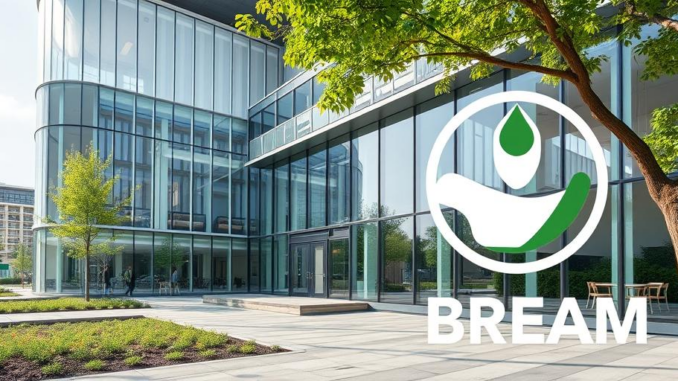
Summary
This article provides a comprehensive guide to achieving BREEAM certification, covering key steps such as understanding the process, early engagement with assessors, and focusing on key criteria. It emphasizes a proactive approach, highlighting the importance of integrating BREEAM considerations from the outset. By following these steps, developers can optimize their projects for sustainability and achieve desired BREEAM ratings.
Discover how Focus360 Energy can help with BREEAM certification.
** Main Story**
Pursuing BREEAM certification? It’s a game-changer when you’re aiming for sustainable, environmentally sound buildings. This isn’t just about ticking boxes; it’s about building better. Let’s walk through how you can nail this process and boost your odds of success.
Understanding the Lay of the Land: BREEAM Demystified
BREEAM, or the Building Research Establishment Environmental Assessment Method, is a big deal globally. It’s a standard that measures how well a building performs environmentally, and that means looking at everything, not just construction, but also how it’s designed, how it’s run, and how it’s kept up. Think of it as a holistic health check for your building, and the scores? They range from “Pass” all the way to “Outstanding”, showing just how sustainable the place really is.
But here’s the thing, you can’t just jump in. You’ve got to figure out which BREEAM scheme fits your project, and that’s because, whether it’s a brand-new building, something that’s already standing, a refurb, or even a whole community, there’s a specific scheme for each. Now, where do you get the lowdown? The BREEAM website is your go-to. And there are other sites, like Encon Associates, that have got your back, too. So, do your homework, because getting this part right is key.
Getting in Early: The Power of Pre-Assessment
Bring in a BREEAM assessor, and the earlier, the better. Seriously, their know-how is gold. They get the criteria, they can help you set goals that aren’t pie-in-the-sky, and they can help build a sustainability plan that actually works. Don’t skimp on this. I’ve seen projects where they thought they could wing it, and, well, it didn’t end well.
Also, do a pre-assessment. That is before you start anything, figure out where you can make things better and what kind of BREEAM rating you’re likely to get. This is your chance to fix problems and tweak your design. Sites like Encon Associates and Wint.ai can give you the scoop on finding an assessor and what the process looks like.
The Nitty-Gritty: Key Criteria to Focus On
Okay, let’s talk specifics. Energy efficiency, water management, materials, waste and then some! You’ve got to think sustainable from the jump. That means energy-smart systems, water-saving gadgets, and materials that don’t cost the earth. And don’t forget the people who’ll be using the building. Good air, light, comfy temperatures, and peace and quiet. That’s what you should aim for, and organisations like CIRCE and Octopus Lab can give you tips on maxing out points in these areas.
And here’s a thought – be innovative. Don’t just do what everyone else is doing. Think outside the box. Also, make sure your building is easy to get to and that people can use eco-friendly transport. It’s about the whole package. I once worked on a project where we installed solar panels in an innovative way, which not only improved our BREEAM score but also reduced the building’s energy bills significantly.
Documentation is your Friend and Teamwork Makes the Dream Work
Keep. Every. Single. Document. Trust me on this. You’ll need it to prove you’re doing what you say you’re doing. And, of course, talk to everyone. Architects, builders, engineers – get them all on the same page. If everyone’s working together, sustainability becomes a team effort.
For example, I had to get BREEAM certification for a previous project and it was made so much easier by ensuring the whole team was working toward the same goal. The result was a seamless project, but it wouldn’t have been if there wasn’t clear communication.
Oh, and one more thing – get your documents in on time. It’ll make the whole process smoother. Resources like Focus 360 Energy and AG5 have some good advice on how to stay on top of things.
The Home Stretch: Post-Construction and Beyond
So, construction’s done. The assessor does their thing and gives you a BREEAM rating. Getting that certification shows you’re serious about sustainability, makes your building more attractive to buyers or tenants, and helps make the world a little greener. And, you know what, BREEAM is not a ‘one and done’ situation. Keep it up. Make sure the building stays sustainable over time. That’s how you get the most out of your certification. Check out articles from Tarkett and Ncg-global.com for ideas on this.
Listen, it can seem like a slog, but it is worth it. Plan early, work with your team, and go for it. And that way you’ll not only get your BREEAM rating, but you’ll also be doing your bit for the environment. Good luck!


The emphasis on early engagement with a BREEAM assessor is crucial. Integrating sustainability considerations from the outset can significantly impact design choices and material selection, potentially leading to more innovative and cost-effective solutions. Has anyone experienced specific benefits from this proactive approach?
Absolutely! The cost-effectiveness you mentioned is a key advantage. We found that early engagement allowed us to explore alternative, sustainable materials that were surprisingly budget-friendly. This proactive approach not only boosted our BREEAM score but also delivered significant long-term savings. I’m interested to hear what innovative material choices others have made!
Editor: FocusNews.Uk
Thank you to our Sponsor Focus 360 Energy
The article highlights the importance of early engagement with a BREEAM assessor. Beyond initial consultation, what strategies can ensure ongoing collaboration with the assessor throughout the project lifecycle, especially during construction and post-occupancy phases?